
Kikuchi clan
Encyclopedia


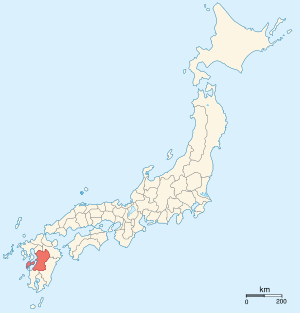
Higo Province
Higo Province was an old province of Japan in the area that is today Kumamoto Prefecture on the island of Kyūshū. It was sometimes called , with Hizen Province. Higo bordered on Chikugo, Bungo, Hyūga, Ōsumi, and Satsuma Provinces....
was a powerful daimyo family of Higo, Kyūshū
Kyushu
is the third largest island of Japan and most southwesterly of its four main islands. Its alternate ancient names include , , and . The historical regional name is referred to Kyushu and its surrounding islands....
. The Kikuchi lineage was renowned for its valiant service in defense of the emperor and against foreign invaders. The clan first distinguished itself during the Jürchen invasion of northern Kyūshū in 1019. The family rose to prominence during the Mongol invasion of Japan in 1281, when the heroism of Kikuchi Takefusa helped drive back the enemy. The family also was active in the Kenmu Restoration (1333-1336), an attempt by the emperor Go-Daigo to reassert imperial authority against the Kamakura shogunate
Kamakura shogunate
The Kamakura shogunate was a military dictatorship in Japan headed by the shoguns from 1185 to 1333. It was based in Kamakura. The Kamakura period draws its name from the capital of the shogunate...
.
This clan descended from Fujiwara clan. However it is questioned as a Baekje
Baekje
Baekje or Paekche was a kingdom located in southwest Korea. It was one of the Three Kingdoms of Korea, together with Goguryeo and Silla....
origin Buddha statue found in their origin site is the same type of Buddha statue belonged to Kikuchi clan, and as the statue was made before Fujiwara clan existed, it's believed that Kikuchi clan was possibly older than Fujiwara clan. Japanese genealogist, Suzuki Matoshi claimed the clan was from Baekje
Baekje
Baekje or Paekche was a kingdom located in southwest Korea. It was one of the Three Kingdoms of Korea, together with Goguryeo and Silla....
while Oota Akira, Japanese historian, claimed the clan originated from Ki clan. Many famous warriors have come from this family such as Kikuchi Takanao
Kikuchi Takanao
is a Japanese warrior, nobleman . He can also can be referred to as Kikuchi no Jiro Takanao or Kikuchi Higo-Gon-no-Kami Takanao....
, Kikuchi Takefusa
Kikuchi Takefusa
Kikuchi Jiro Takefusa was the second son of Takayasu. In 1274 during the first Mongol invasion he fought with his brother Aritaka and were awarded...
who stopped the Mongols in the Mongol Invasions of Japan
Mongol invasions of Japan
The ' of 1274 and 1281 were major military efforts undertaken by Kublai Khan to conquer the Japanese islands after the submission of Goryeo to vassaldom. Despite their ultimate failure, the invasion attempts are of macrohistorical importance, because they set a limit on Mongol expansion, and rank...
, Kikuchi Taketoki
Kikuchi Taketoki
Kikuchi Ikejiro nyudo Jakua was the 12th head of the Kikuchi Clan. He was born the second son of Kikuchi Takamori and he was the younger brother of Kikuchi Tokitaka . His child name was Shoryumaru. During his life, he would also use the name Jakua. His father Takamori died before his grandfather...
and Kikuchi Takemitsu
Kikuchi Takemitsu
was a general in the Nanboku-chō period of Japanese history. He fought on the side of the emperor, along with Prince Kanenaga . His famous battle was in Kyūshū....
. Their stories have become some of the most colorful in the history of Japan. Along with the Ōtomo, Ōuchi, Shōni and Shimazu they would write the history of the island of Kyūshū.
The Kikuchi clan was taken out of power in Higo when the Ōuchi family
Ouchi family
The ' was one of the most powerful and important families in Japan during the reign of the Ashikaga shogunate in the 12th to 14th centuries descended from the Korean Baekje Dynasty's Royal family...
took control over Kyūshū
Kyushu
is the third largest island of Japan and most southwesterly of its four main islands. Its alternate ancient names include , , and . The historical regional name is referred to Kyushu and its surrounding islands....
. Many of the members of the clan went into hiding either by moving or entering another family. A notable descendant of the Kikuchi is Hayashi Narinaga
Hayashi Narinaga
was a busho during the Sengoku period, retainer of the Mōri clan and was koku-jin-ryoshu of Southern Bingo Province. He held many jobs including karō serving Mōri Motonari and Môri Mototoshi mostly in dealings with Toyotomi Hideyoshi. He was also a bugyō under Mōri Terumoto. From Hideyoshi he...
, a general for Toyotomi Hideyoshi
Toyotomi Hideyoshi
was a daimyo warrior, general and politician of the Sengoku period. He unified the political factions of Japan. He succeeded his former liege lord, Oda Nobunaga, and brought an end to the Sengoku period. The period of his rule is often called the Momoyama period, named after Hideyoshi's castle...
and Mori Motonari
Mori Motonari
was a prominent daimyō in the west Chūgoku region of Japan during the Sengoku period of the 16th century.-Early years:Mōri Motonari was born under the name Shojumaru in a small domain of Aki province in 1497. He is said to have been born at Suzuo Castle, his mother's homeland...
.
Kikuchi Noritaka
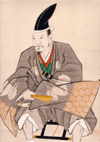
Fujiwara Takaie
, the regional governor of Kyūshū . Takaie had been sent down from Kyoto to Kyūshū. He was the son of Fujiwara no Michitaka.Takaie successfully led the defense of Dazaifu against the Toi invasion of 1019...
went back to Kyoto, he retired in 1070 (2nd year of Enkyū
Enkyu
was a after Jiryaku and before Jōhō. This period spanned the years from April 1069 through August 1074. The reigning emperors were and .-Change of Era:* 1069 : The new era name was created to mark an event or series of events...
)and built a retirement villa in Kikuchi-gun where he lived until he died. The remains of his villa can still be seen today. In 1071 (3rd year of Enkyū
Enkyu
was a after Jiryaku and before Jōhō. This period spanned the years from April 1069 through August 1074. The reigning emperors were and .-Change of Era:* 1069 : The new era name was created to mark an event or series of events...
) became master of Kikuchi District, Higo Province. There he established a castle town with retainers. Today there is a city in Kumamoto Prefecture
Kumamoto Prefecture
is a prefecture of Japan located on Kyushu Island. The capital is the city of Kumamoto.- History :Historically the area was called Higo Province; and the province was renamed Kumamoto during the Meiji Restoration. The creation of prefectures was part of the abolition of the feudal system...
called Kikuchi, Kumamoto
Kikuchi, Kumamoto
is a city located in Kumamoto, Japan.The city was founded on August 1, 1958. On March 22, 2005, the city merged with the municipalities of Kyokushi, Shichijo and Shisui into a new expanded city of Kikuchi. As of December 2006, the city has an estimated population of 52,646 and a density of 190.3...
.
Noritaka's father was named Masanori (政則) and worked for the Fujiwara clan. It was a mistake that genealogists believed that he was named Fujiwara Masanori. New records show that he actually worked for the Fujiwara instead of being part of their family. Masanori was awarded a katana (samurai sword) for military service in time of war. "April 3, 1022 it is recorded that Masanori is appointed the governor of Tsushima as reward for service against Toi invaders. After the establishement of the title his name was changed to Tsushima-no-Kami Kuranori." "Shōyūki, Jian 2/4/3"
The grandfather of Noritaka and father of Masanori was named Chikanori (親則). He worked for Fujiwara Takaie
Fujiwara Takaie
, the regional governor of Kyūshū . Takaie had been sent down from Kyoto to Kyūshū. He was the son of Fujiwara no Michitaka.Takaie successfully led the defense of Dazaifu against the Toi invasion of 1019...
(藤原 隆家) (979-1044),
Kikuchi Takanao (?-1185)
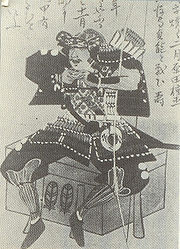
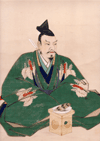
When Kikuchi Takanao
Kikuchi Takanao
is a Japanese warrior, nobleman . He can also can be referred to as Kikuchi no Jiro Takanao or Kikuchi Higo-Gon-no-Kami Takanao....
sided with Minamoto no Yoritomo
Minamoto no Yoritomo
was the founder and the first shogun of the Kamakura Shogunate of Japan. He ruled from 1192 until 1199.-Early life and exile :Yoritomo was the third son of Minamoto no Yoshitomo, heir of the Minamoto clan, and his official wife, a daughter of Fujiwara no Suenori, who was a member of the...
and began levying troops in Kyūshū
Kyushu
is the third largest island of Japan and most southwesterly of its four main islands. Its alternate ancient names include , , and . The historical regional name is referred to Kyushu and its surrounding islands....
in 1180, at the beginning of the Gempei War, Taira no Sadayoshi
Taira no Sadayoshi
Taira no Sadayoshi was a governor of Higo and Chikugo provinces in Kyūshū, and a samurai commander for the Taira clan during the Genpei War of the 1180s. Following the war, his life was spared as a result of an intercession by Utsunomiya Tomotsuna. He thus spent his retirement as a Buddhist monk,...
marched against him and defeated Takanao. Kikuchi Takanao was present at the battle of Dannoura. Shortly after the battle in the same year, he was turned over to Minamoto Yoshitsune by his lord Ogata no Saburo Koreyoshi
Ogata no Saburo Koreyoshi
, nicknamed , is a Japanese nobleman, warrior who played a major role in the establishment of the Kamakura shogunate. His full name is .The "Tales of Genji" establish that Ogata commanded the largest armies on Kyūshū....
. He was taken to the Rokujo riverbed and his head was cut off.
"One of your retainers, Kikuchi no Jiro Takanao, has been my enemy for years," ... "You may rely on me if you will turn Kikuchi over for execution."
-Minamoto Yoshitsune
"At the end of the twelfth century events far away in eastern Japan led to the establishment of Japan's first military government, the Kamakura shogunate
Kamakura shogunate
The Kamakura shogunate was a military dictatorship in Japan headed by the shoguns from 1185 to 1333. It was based in Kamakura. The Kamakura period draws its name from the capital of the shogunate...
, which, during the initial stages at least, ran in tandem with the old imperial administration. The wars surrounding the birth of this new regime saw the Kikuchi clan coalesce into a powerful warrior league, or bushidan. In 1181/2, their leader Kikuchi Takanao
Kikuchi Takanao
is a Japanese warrior, nobleman . He can also can be referred to as Kikuchi no Jiro Takanao or Kikuchi Higo-Gon-no-Kami Takanao....
, joined with Ogata Koreyoshi
Ogata no Saburo Koreyoshi
, nicknamed , is a Japanese nobleman, warrior who played a major role in the establishment of the Kamakura shogunate. His full name is .The "Tales of Genji" establish that Ogata commanded the largest armies on Kyūshū....
of Bungo
Bungo Province
was a province of Japan in eastern Kyūshū in the area of Ōita Prefecture. It was sometimes called , with Buzen Province. Bungo bordered Buzen, Hyūga, Higo, Chikugo, and Chikuzen Provinces.-History:...
, another important local warrior, in rebellion against the Taira, which converted them into de facto allies of Minamoto Yoritomo, founder of the Bakafu. This rising was, however, crushed by Haruda Tanenao. Then, perversely, as the fighting drwe to a close and the Taira star waned, the Kikuchi chose to align themselves with the erstwhile enemies and, together with the leading Kyūshū warriors including the Haruda, Yamaga, and Itai, suffered a crushing defeat at the hands of the now triumphant Bakafu. The battle took place off the coast of Kyūshū, at Dannoura, and it saw the emergence of Minamoto Yoritomo as Japan's unquestioned military leader. His forces were drawn largely from the east, while, in the dying moments, the Taira had relied almost exclusively on warriors from Kyūshū. The new military regime, therefore, titled decidedly toward the east and against the west, a fact that was to have profound consequences for the island's future."
Kikuchi Yoshitaka (1200's)
Yoshitaka was the great-grandson of Takanao. During the Gempei War he was fighting together with the Heike and even though they were on the losing side the GenjiGenji
was a after Bunkyū and before Keiō. This period spanned only slightly more than a single year from February 1864 through April 1865. The reigning emperor was .-Change of era:...
permitted them to keep their land. In 1221 during the battle of Shokyu no ran, Kikuchi Yoshitaka's job was Kyoto's Obanyaku. He had two uncles and he dispatched them both to Kyoto. They followed the Gotobajoko (retired Emperor) and the Kamakura shogunate
Kamakura shogunate
The Kamakura shogunate was a military dictatorship in Japan headed by the shoguns from 1185 to 1333. It was based in Kamakura. The Kamakura period draws its name from the capital of the shogunate...
was not happy with this. The Kikuchi's land was increased because of this.
Kikuchi Takefusa (1245-Mar 26, 1285)
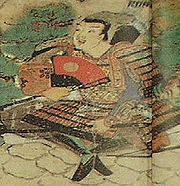
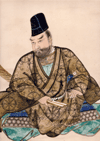
Takefusa was the second son of Takayasu and grandson of Yoshitaka. In 1274 during the first Mongol invasion (Bunye) he fought with his brother Aritaka and were awarded. The family rose to prominence during the second Mongol invasion of Japan in 1281, when the heroism of Kikuchi Takefusa (12451285) helped drive back the enemy. The Mongolian Force that landed from the Momochi field divided into two groups,being attacked by Kikuchi Takefusa at Akasaka, the greater group retreated to the hill of Sohara,and the smaller group to Tukahara field in Befu. The Mongolian Force pitched a camp in Sohara field. The Sohara field had a hill with the height of 30m and had a good view over the streets of Fukuoka city,and now is called Soharakouen Park. The stone monument in the center of Soharakouen Park shows the remains of battles of the Mongolian Invasion. Takefusa gained fame for all the heads of the enemy that he collected. He died at the age of 41.
Kikuchi Tokitaka (1287-1304)
Also known as Kikuchi Jirō TokitakaHe was the first son and heir of Kikuchi Takamori, grandon of Kikuchi Takefusa. He died very young when he was only seventeen years old so his younger brother and second son of Takamori, Kikuchi Taketoki became the next head of the family.
Kikuchi Taketoki (1292-Apr 27, 1333)
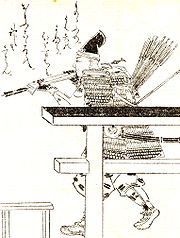
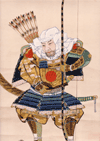
Taketoki was the 12th head of the Kikuchi Clan. He was born the second son of Kikuchi Takamori and he was the younger brother of Kikuchi Tokitaka (first son). His child name was Shoryumaru. During his life he would also use the name Jakua. His father Takamori died before his grandfather Takefusa. Takamori's brother Takenori and Taketoki's brother Tokitaka fought each other for power and both ended up dying. Therefore Taketoki became head of the clan. In 1333 Emperor Go-Daigo asked for Taketoki to help him. He was Go-Daigo's first man and was awarded for this. Taketoki gathered many people in Kyūshū was planning to attack Chinzei Tandai's Hojo Hidetoki (Akahashi Hidetoki) but they found out about his plan and they attacked him first. Taketoki and his son Yoritaka died in this attack and was 42 years old. Taketoki was buried in Fukuoka city. He has one grave for his head and one grave for his midsection. Kikuchi Shrine in Kikuchi City was made in his honor. He has 12 children in all. He was a clever samurai but Hojo Hidetoki did not underestimate him. He burned down Hakata and attacked. Otomo Uji's support never came to help Taketoki. After this a movement began to overthrow Hojo Hidetoki. Taketoki's next in line was Takeshige and he was prized Higo no Kuni. He was captured with his sons and beheaded. The enemy used their heads for archery practice.
From the Hakata Nikki:
"So the heads of Kikuchi nyudo, his son Saburo, Jakua's younger brother Kakusho, and the wakato were hung up in the place where warriors practice shootings dogs from horses. Jakua's, Saburo's, and Kakusho's [heads] were displayed separately. In the evening they were taken down and placed in the residence where they remained for about ten days. Then they were nailed to a board and a sign said that they were heads of the rebels, Kikuchi Taro nyuda Jakua, his son Saburo, and Jakua's younger brother, Jiro Saburo nyudo Kakusho."
"My ancestral home,
Will you wait
For a man who knows not
if tonight will be
His last?"
-death poem that Kikuchi Taketoki wrote and had sent to his wife when he was surrounded by his enemies.
Kikuchi Takeshige (1307-1338)
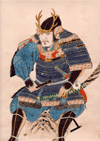
Kikuchi Takehito (1321-1401)
After the first son of Taketoki, Takeshige died he became the next head of the clan. He had other older brothers but he was the only one born from the head wife. He ruled weakly and so his older brothers Takeshige and Toketoshi helped him with the clan. The Kikuchi were attacked by the Otomo clan and he wasn't able to handle the military situation so his brother Takemitsu took over the family and pushed him out. Takehito then became a priest and died at an old age.Kikuchi Taketoshi (?-1341)
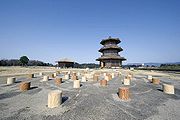
"Taketoshi fought against the Ashikaga and Northern Court as his brothers and father. Taketoshi went to the assistance of Nitta in the East, but his younger brother, together with other Kyūshū leaders, remained on the alert at Higo, where the Kikuchi family had its stronghold. Thus Takauji had to reckon with an influential group, including such promising men as Aso, Mihara, and Kuroki, who were at one in desiring to check his progress in Kyūshū. They had entered Higo for that purpose a few days before Takauji crossed the Straits.
Early in April Taketoshi attacked the Shoni stronghold at Dazaifu, Chikuzen Province. He succeeded in reducing the fort and driving out Shoni Sadatsune who made a stand in the neighboring hills but was thoroughly defeated and committed suicide with several of his kinsmen."
Battle of Tatarahama
Battle of Tatarahama (1336)
The 1336 battle of Tatarahama was one of many battles constituting the Nanboku-chō Wars in Japan, in which two rival Imperial Courts battled for legitimacy and control of the country...
(April, 1336) - Kyūshū falls to Northern Imperial Court
Early in 1336, a number of Kyūshū clans, anticipating the movements of the shogun's army against them, made efforts to unite and present a formidable resistance. A number of skirmishes were fought against clans loyal to the shogun on the island, including a siege of Dazaifu, in which the Shōni clan stronghold was taken; Shōni Sadatsune fled, but was defeated soon afterwards, and committed suicide along with a number of his retainers.
Shogun Ashikaga Takauji, arriving in Munakata, a short distance away, at this time in early April, learned of the siege of Dazaifu and the death of Shōni Sadatsune. Gathering forces, he marched from Munakata on April 15, and journeyed to Tatarahama, fifteen miles (24 km) away, where he met the opposing army, consisting primarily of warriors of the Kikuchi, Aso, Mihara, and Kuroki clans under the command of a Kikuchi Taketoshi.
The military chronicle Baishō-ron describes Tatarahama as "a stretch of over three miles (5 km) of dry foreshore, crossed at the south end by a small stream. The precincts of the Hakozaki Hachiman Shrine consist of some five square miles of pine forest. To the south lies the city of Hakata."
By the end of the battle, the Kikuchi clan forces had been chased by Ashikaga Tadayoshi to Dazaifu, at which point they fled into the hills. The Aso and Akizuki clan commanders committed suicide, and other commanders simply surrendered.
Takauji rewarded his commanders for their bravery and service, but offered pardon to his opponents, and to several clans not participating in the battle, who thus joined him in its aftermath. Kyūshū thus became united under the shogunate, and the Northern Imperial Court.
Kikuchi Takemitsu (1319-1373)
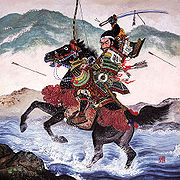
Emperor Go-Daigo
Emperor Go-Daigo was the 96th emperor of Japan, according to the traditional order of succession....
). The scene where he fights a famous battle on the Chikugo river is drawn in the picture on the right. He was the strongest and most dependable ally of Prince Kanenaga in the struggle against the Bafuku. He was stuck with a triple threat by the armies of Ashikaga Yoshinori, Ashikaga Takasaki and Ashikaga Tadaaki. This made Takemitsu have to raise the siege of Takasaki and address himself to the defence of Daizaifu. The three Ashikaga armies enveoloped Daizaifu and it fell into their hands before the end of September 1372. Takemitsu had to retreat and escaped to Chikugo with Prince Kanenaga. When Takemitsu died he left the loyalist defence without a really tested leader, and his heir Takemasa, a promising soldier, died in 1374.
The Battle of Oohobaru (The Battle of Chikugo River):
Forty thousands which followed Kikuchi Takemitsu as their head advanced northwards from Kikuchi in Kumamoto with Prince Kanenaga, and were opposed to North Dynasty's Army across the Chikugo River. Kikuchi Takemitu commanded 5000 soldiers to cross the Chikugo River, and pitched a camp around present Miyase. The unit of Kikuchi Takemitsu went along the present Oomuta Railway Line northwards,and headed for Ajisaka. But,forces of the Shouni Family avoided the fight and retreated to the point near present Ooho station. Although, as for this battle line, the stalemate continued for half a month,on the midnight of August 15, Takemitsu finally took the suicide corps of 3000 and moved quietly on the east side of the forces of the Syouni, and attacked it from both sides. In a short while, 1000 horsemen headed by Kikuchi Takemasa arrived there for the help and the Battle of Oohobaru started. Although both armies repeated fierce fight of advance and retreat around Ogoori,the Kikuchi army pressed the Shouni army gradually, the Shouni army retreated along present the Amagi Railway Line toward northeast to arrive at Yamakumahara which spread over present Tachiarai. Although the Shoni army tried to reorganize the disrupted forces at Mt. Hanatateyama, they ran into Mt. Houmanzan 15 kilometers north because they were scattered by the fierce pursuit of the Kikuchi army which didn't give any spare time for them.
Kikuchi Takemasa (July 6, 1342-May 26, 1374)
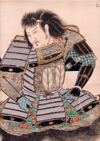
Born the first son of Takemitsu on July 6, 1342, he fought in Kyūshū against the Northern Court with his father and had great success. When Imagawa Sadayo
Imagawa Sadayo
, also known as ', was a renowned Japanese poet and military commander who served as tandai of Kyūshū under the Ashikaga Bakufu from 1371 to 1395. His father, Imagawa Norikuni, had been a supporter of the first Ashikaga Shogun, Ashikaga Takauji, and for his services had been granted the position...
(今川貞世) (1326-1420) became head of the opposing army things starting going sour for the Kikuchi. In November, 1333 his father died and he became the head of the clan and hearing about the death of Takemitsu, Imagawa attacked and won many battles against Takemasa. Kikuchi Takemasa asked Aso Koretaka for help and he was one of their most trusted retainers in the war against the North. Takemasa died just one year after his father on May 26, 1374.
Kikuchi Taketomo (1363-1407)
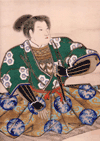
Fujiwara no Michitaka
, the first son of Kaneie, was a Kugyō of the Heian period. He served as regent for the Emperor Ichijō, and later as Kampaku...
and Michitaka's fourth generation descendant Noritaka came to live in Higo. He sent a copy of the genealogy to the government. This move was explained with the failing position of the Kikuchi at the time and showing ancestry from the Fujiwara would give the Kikuchi some more prestige and power. Masanori's father Chikanori is though to be a descendant of Baekje
Baekje
Baekje or Paekche was a kingdom located in southwest Korea. It was one of the Three Kingdoms of Korea, together with Goguryeo and Silla....
immigrants. Taketomo shows up in the Tale of Genji where Lady Murakami calls him Chuwamono (powerful leader in the wilderness).
Kikuchi Yoshiyuki (1482-1504)

Kikuchi Takekane (?-1532)
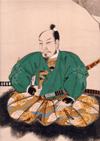
Kikuchi Yuriko (1505-1554)
The last and 26th head of the Kikuchi Clan before the rule of Higo went to the Ōtomo even though he was from that clan himself."The head of the Ōtomo family, Ōtomo Yoshiaki placed his younger brother Ōtomo Shigeharu as the fictive heir of the famous tradition rich but now extinct shugo family, the Kikuchi of Higo. Yoshiaki's son was the famous Ōtomo Sōrin
Otomo Sorin
, also known as Fujiwara no Yoshishige and Ōtomo Yoshishige , was a Japanese feudal lord of the Ōtomo clan, one of the few to have converted to Christianity. The eldest son of Ōtomo Yoshiaki, he inherited the domain of Funai, on Kyūshū, Japan's southernmost main island, from his father...
(大友 宗麟) (1530-1587). Kikuchi Yoshitake did not act as a puppet at all though and placed his bets on the Ōuchi to prevail in Northern Kyūshū and took up arms against Yoshiaki. But he was no match for his older brother and was brushed aside. By 1543, Ōtomo Yoshiaki's hold on Higo was solid enough to make his appointment as shugo of that province. When he recovered Higo-Kumamoto Castle, his retainer Akahoshi Chikaie (赤星親家) sided with the Ōtomo. Chikaie later fought against Yoshitake's other retainer, Kumabe Chikanaga, and died. Ōtomo Sōrin
Otomo Sorin
, also known as Fujiwara no Yoshishige and Ōtomo Yoshishige , was a Japanese feudal lord of the Ōtomo clan, one of the few to have converted to Christianity. The eldest son of Ōtomo Yoshiaki, he inherited the domain of Funai, on Kyūshū, Japan's southernmost main island, from his father...
(Ôtomo Yoshishige ) became head of the Ôtomo in 1550 and his uncle Kikuchi Yoshitake declared his independence about the same time. Sôrin marched against him and destroyed him in 1554 ending the long line of the Kikuchi clan.
Kikuchi Family Heads
- Chikanori (親則)
- Masanori (政則)
- Kikuchi Noritaka (菊池 則隆) (11th c.) (Kikuchi progenitor)
- Kikuchi Tsunetaka (菊池 経隆) (11th c.)
- Kikuchi Tsuneyori (菊池 経頼) (12th c.)
- Kikuchi Tsunemune (菊池 経宗) (12th c.)
- Kikuchi Tsunenao (菊池 経直) (12th c.)
- Kikuchi TakanaoKikuchi Takanaois a Japanese warrior, nobleman . He can also can be referred to as Kikuchi no Jiro Takanao or Kikuchi Higo-Gon-no-Kami Takanao....
(菊池 隆直) (?-1185) - Kikuchi Takatada (菊池 隆定) (13th c.)
- Kikuchi Takatsugu (菊池 隆継) (13th c.)
- Kikuchi Yoshitaka (菊池 隆能) (13th c.)
- Kikuchi Takayasu (菊池 隆泰) (13th c.)
- Kikuchi TakefusaKikuchi TakefusaKikuchi Jiro Takefusa was the second son of Takayasu. In 1274 during the first Mongol invasion he fought with his brother Aritaka and were awarded...
(菊池 武房) (1245-1285) (r. 12??-1285)- Kikuchi Takamori (菊池 隆盛) (13th-14th c.)
- Kikuchi Tokitaka (菊池 時隆) (1287-1304) (r. 12??-1304
- Kikuchi TaketokiKikuchi TaketokiKikuchi Ikejiro nyudo Jakua was the 12th head of the Kikuchi Clan. He was born the second son of Kikuchi Takamori and he was the younger brother of Kikuchi Tokitaka . His child name was Shoryumaru. During his life, he would also use the name Jakua. His father Takamori died before his grandfather...
(菊池 武時) (1292-1333) (r. 1304-1333) - Kikuchi Takeshige (菊池 武重) (1307-1338) (r. 1333~1338)
- Kikuchi Takehito (菊池 武士) (1321-1401) (r. 1338~1345)
- Kikuchi TakemitsuKikuchi Takemitsuwas a general in the Nanboku-chō period of Japanese history. He fought on the side of the emperor, along with Prince Kanenaga . His famous battle was in Kyūshū....
(菊池 武光) (1319-1373) (r. 1345~1372) - Kikuchi Takemasa (菊池 武政) (1342-1374) (r. 1372~1374)
- Kikuchi Taketomo (菊池 武朝) (1363-1407) (r. 1374~1407)
- Kikuchi Kanetomo (菊池 兼朝) (1383-1444) (r. 1407~1431)
- Kikuchi Mochitomo (菊池 持朝) (1409-1446) (r. 1431~1446)
- Kikuchi Tamekuni (菊池 為邦) (1430-1488) (r. 1446~1466)
- Kikuchi Shigetomo (菊池 重朝) (1449-1493) (r. 1466~1493)
- Kikuchi Yoshiyuki (菊池 能運) (1482-1504) (r. 1493~1504)
- Kikuchi Masataka (菊池 政隆) (1491-1509) (r. 1504~1505)
- Kikuchi Taketsune (菊池 武経) (1480-1537) (r. 1505~1511)
- Kikuchi Takekane (菊池 武包) (?-1532) (r. 1511~1520)
- Kikuchi Yuriko (菊池 義武) (1505-1554) (r. 1520~1554)
Genealogy
Chikanori┃
Masanori
┃
(1)Kikuchi Noritaka
┣━━━━━━━━━━━━━━━━━━━━━━━━━━━━━━━━━━━━┳━━━━━━━━━━━━━━━━━━━━━━━━━━━┓
(2)Tsunetaka (Hyodo clan - ) Yoritaka (Kojima clan - ) Masataka (Saigo clan - 西郷氏)
┃
(3)Tsuneyori
┃
(4)Tsunemune
┃
(5)Tsunenao
┣━━━━━━━━━━━━━━━━━━━━━━━━━━━━━━━━━━━━━━━━━┓
(6)Takanao
Kikuchi Takanao
is a Japanese warrior, nobleman . He can also can be referred to as Kikuchi no Jiro Takanao or Kikuchi Higo-Gon-no-Kami Takanao....
(Akahoshi clan - 赤星氏)
┃
(7)Takatada
┃
Takatsugu
┃
(8)Yoshitaka
┣━━━━━━━━━━━━┳━━━━━━━━━━━━┳━━━━━━━━━━━━━━━━━━━━━━━━━━━━━━━━━━━━┓
(9)Takayasu Takatsune (Jô clan - 城氏) Takayori (Jô clan - 城氏)
┣━━━━━━━━━━━━┳━━━━━━━━━━━━┳━━━━━━━━━━━━━━━━━━━━━┳━━━━━━━━━━━━━━━━━━━━━━━━━━━━━┳━━━━━━━━━━━━━━━━━┳━━━━━━━━┳━━━━━━━━┓
(10)Takefusa Naotaka Yoritaka Aritaka (Akahoshi clan - 赤星氏) (Wakamiya clan) Takafuyu Yasunari Shigemune
┣━━━━━━━━━━━━┳━━━━━━━━━━━━┳━━━━━━━━━━━┳━━━━━━━━━━━┳━━━━━━━━━━━━┳━━━━━━━━━━┓
Takamori Michitake Takemoto Takenari Taketsune Takekado Takemura
┣━━━━━━━━━━━━┓
(11)Tokitaka (12)Taketoki
┣━━━━━━━━━┳━━━━━━━━┳━━━━━━┳━━━━━━━━┳━━━━━━━━┳━━━━━━┳━━━━━━━━━┳━━━━━━━━━━━┳━━━━━━━━━━━┳━━━━━━━━━━┳━━━━━━━━━━━━┳━━━━━━━┳━━━━━━┓
(13)Takeshige Yoritaka (14)Takehito Takeyoshi Taketoshi (15)Takemitsu Takezumi Takenao ( Takase clan - ) Taketoyo
┃ ┃ ┃
(16)Takemasa Takemoto Takekuni
┃ ┃ ┃
(17)Taketomo Moritake Takenaga (adopted to Hayashi clan - 林氏)
┃ ┃ ┃
(18)Kanetomo Yasuharu Hayashi Narinaga
Hayashi Narinaga
was a busho during the Sengoku period, retainer of the Mōri clan and was koku-jin-ryoshu of Southern Bingo Province. He held many jobs including karō serving Mōri Motonari and Môri Mototoshi mostly in dealings with Toyotomi Hideyoshi. He was also a bugyō under Mōri Terumoto. From Hideyoshi he...
┃ ┃
(19)Mochitomo Takeyasu
┃ ┃
(20)Tamekuni (25)Takekane
┣━━━━━━━━┳━━━━━━━┓
(21)Shigetomo 武邦 重安
┃ ┃
(22)Yoshiyuki (23)Masataka
┃┃
(24)Taketsune (adopted from Asa clan - 阿蘇氏)
┃┃
(25)Takekane (from Takezumi line)
┃┃
(26)Yoshitake (Ōtomo Shigeharu - 大友氏)
Family Tree in Japanese

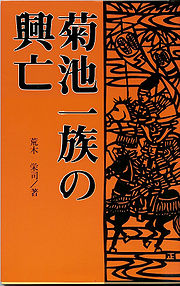
Retainers
- Akahoshi clan (赤星氏) - cadet branch of the Kikuchi clan
- Akahoshi Chikaie (赤星親家) (1514-1562)
- Akahoshi Muneie (赤星統家) (1530-1619)
- Kumabe clan (隈部氏)
- Kumabe ChikanagaKumabe ChikanagaKikuchi retainer, lord of Higo-Nagano Castle. He later served the Ryūzōji. He was defeated during Hideyoshi Toyotomi's conquest of Kyūshū. He later died in the Higo riots....
(隈部親永) (1516-1588) - Kumabe Chikayasu (隈部親泰)
- Takezaki clan (竹崎氏)
- Takezaki SuenagaTakezaki Suenagawas a retainer of the Higo Province, Japan who fought in both the Battle of Bun'ei and the Battle of Kōan during the Mongol invasions of Japan. Suenaga commissioned the Mōko Shūrai Ekotoba, a pictorial scroll showing his own valor in war, composed in 1293. During the Mongol invasion of 1274,...
(竹崎季長) (1236-1314)- Saigo clan (西郷氏) - cadet branch of the Kikuchi clan
- Jô clan (城氏) - cadet branch of the Kikuchi clan
- Jô Takeaki
- Kashiki clan (鹿子木氏)
- Udo clan (宇土氏)

